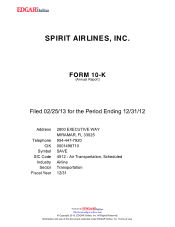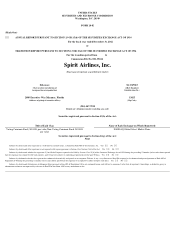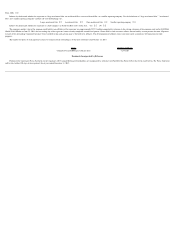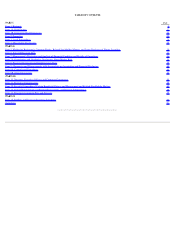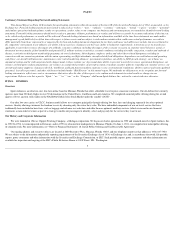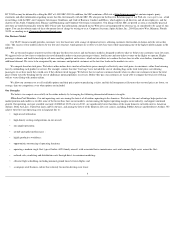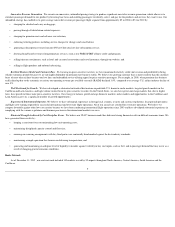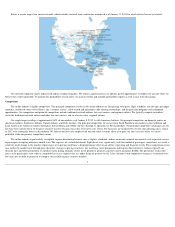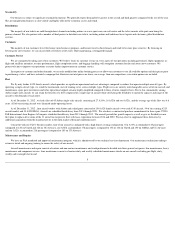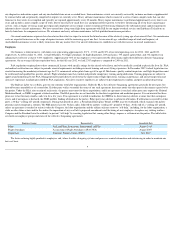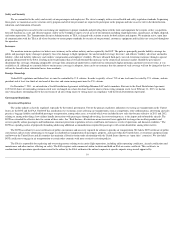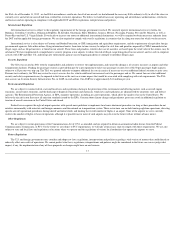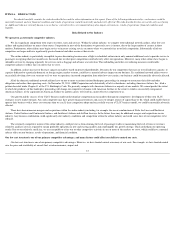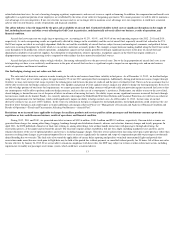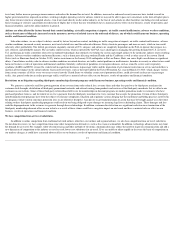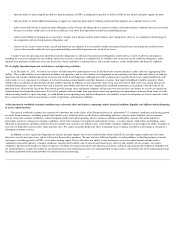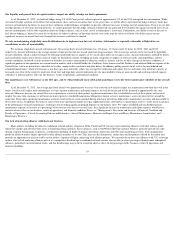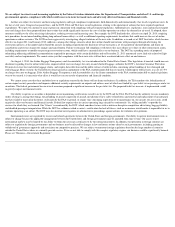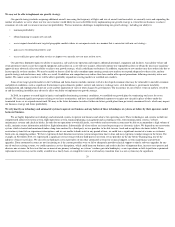Spirit Airlines 2012 Annual Report Download - page 11
Download and view the complete annual report
Please find page 11 of the 2012 Spirit Airlines annual report below. You can navigate through the pages in the report by either clicking on the pages listed below, or by using the keyword search tool below to find specific information within the annual report.
Safety and Security
We are committed to the safety and security of our passengers and employees. We strive to comply with or exceed health and safety regulation standards. In pursuing
these goals, we maintain an active aviation safety program and all of our personnel are expected to participate in the program and take an active role in the identification,
reduction, and elimination of hazards.
Our ongoing focus on safety relies on training our employees to proper standards and providing them with the tools and equipment they require so they can perform
their job functions in a safe and efficient manner. Safety in the workplace targets several areas of our operation including: flight operations, maintenance, in-flight, dispatch,
and station operations. The Transportation Security Administration, or TSA, is charged with aviation security for both airlines and airports. We maintain active, open lines
of communication with the TSA at all of our locations to ensure proper standards for security of our personnel, customers, equipment and facilities are exercised throughout
the operation.
Insurance
We maintain insurance policies we believe are customary in the airline industry and as required by the DOT. The policies principally provide liability coverage for
public and passenger injury; damage to property; loss of or damage to flight equipment; fire and extended coverage; directors’ and officers’ liability; advertiser and media
liability; cyber risk liability; fiduciary; and workers’ compensation and employer’s liability. We have obtained third-party war risk (terrorism) insurance through a special
program administered by the FAA, resulting in lower premiums than if we had obtained this insurance in the commercial insurance market. Should the government
discontinue this coverage, obtaining comparable coverage from commercial underwriters could result in substantially higher premiums and more restrictive terms, if it is
available at all. Although we currently believe our insurance coverage is adequate, there can be no assurance that the amount of such coverage will not be changed or that we
will not be forced to bear substantial losses from accidents.
Foreign Ownership
Under DOT regulations and federal law, we must be controlled by U.S. citizens. In order to qualify, at least 75% of our stock must be voted by U.S. citizens, and our
president and at least two-thirds of our board of directors and senior management must be U.S. citizens.
On December 7, 2011, we entered into a Stock Distribution Agreement with Indigo Miramar LLC and its members. Pursuant to the Stock Distribution Agreement
10,576,180 shares of outstanding common stock were exchanged on a share-for-share basis for shares of non-voting common stock. As of February 11, 2013, we had no
non-voting shares outstanding due to the conversion of all non-voting shares to voting shares in compliance with the Stock Distribution Agreement.
Government Regulation
Operational Regulation
The airline industry is heavily regulated, especially by the federal government. Two of the primary regulatory authorities overseeing air transportation in the United
States are the DOT and the FAA. The DOT has jurisdiction over economic issues affecting air transportation, such as competition, route authorizations, advertising and sales
practices, baggage liability and disabled passenger transportation, among other areas, several of which were included in new rules that became effective in 2011 and 2012
relating to, among other things, how airlines handle interactions with passengers through advertising, the reservation process, at the airport and on board the aircraft. The
DOT has extended the effective date for certain of these rules. See “Risk Factors—Restrictions on or increased taxes applicable to charges for ancillary products and
services paid by airline passengers and burdensome consumer protection regulations or laws could harm our business, results of operations and financial condition.” The
DOT has a pending notice of proposed rulemaking addressing additional accommodations required for passengers with certain disabilities among other matters.
The DOT has authority to issue certificates of public convenience and necessity required for airlines to provide air transportation. We hold a DOT certificate of public
convenience and necessity authorizing us to engage in scheduled air transportation of passengers, property, and mail within the United States, its territories and possessions
and between the United States and all countries that maintain a liberal aviation trade relationship with the United States (known as “open skies” countries). We also hold
DOT certificates to engage in air transportation to certain other countries with more restrictive aviation policies.
The FAA is responsible for regulating and overseeing matters relating to air carrier flight operations, including airline operating certificates, aircraft certification and
maintenance and other matters affecting air safety. The FAA requires each commercial airline to obtain and hold an FAA air carrier certificate. This certificate, in
combination with operations specifications issued to the airline by the FAA, authorizes the airline to operate at specific airports using aircraft approved by
10

